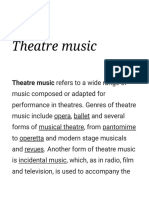Mini-Unit: Electronic Sports
Table of Contents > Mini-Unit > Mini-Unit Overview
Mini-Unit Overview
Introduction
Welcome to this Mini-Unit. Throughout this course, we have examined sport, fandom, and their shared impact on
individuals and society. In conducting these analyses, we have focused entirely on traditional physical sports, such as
football, hockey, or figure skating. By contrast, this unit will focus on the latest frontier of sports, known as electronic
sports, or esports. Esports is competitive video game playing, with athletes playing videogames at the highest levels for
massive audiences of fans. This unit will discuss the similarities between esports and traditional sports, covering fandom
and esports’ fulfillment of the same functional imperatives as traditional fandom. It will also contrast esports with traditional
sports, discussing how this new medium of sports competition differentiates itself from traditional sports, as well as
provide a brief history of electronic sports.
Esports first emerged in the early 1970s, with Japanese competitions such as the All Japan TV Game Championships in
Tokyo leading to nationwide competition at various arcade games. Eventually, esports spread to becoming an
international phenomenon, and in the early 1980s the first professional esports players emerged, with early pros like Billy
Page 1 of 6
�Mitchell being featured in media like Time Magazine and the Guiness Book of World Records. During this period, esports
were primarily individual, with players competing to achieve high scores (Borowy & Yong-Jin, 2013). This changed in 1991
with the release of Street Fighter II, which allowed two athletes to compete directly against each other with a depth of
strategy and a degree of individual expression that had never previously been captured in an arcade game. Street Fighter
II transformed esports from a solo pursuit into a combat sport like boxing, and from this point on the majority of esports
play became directly competitive. Today, most professional esports play is between individuals or teams, with both
primarily receiving income from corporate sponsors and fan contributions.
Whie many might think that esports play primarily occurs over the internet, the reality is that most major esports events
happen in-person. It is these events, and the money involved, that cement esports as a rival for traditional sports. As early
as 2004, over 100,000 fans attended the StarCraft Pro League Finals in Busan (Haps, 2025). In 2021, DotA 2’s The
International had a fan-funded prize pool of $41 million dollars (Liquipedia, 2021). These events have unique fan
experiences, with a high focus on interactivity and crowd engagement. Often, the screens at these events are the primary
appeal, with athletes gathering below massive displays.
Fandom in esports differs from traditional sports fandom in its level of connection between fans and the objects of their
fandom. Unlike traditional sports, where players are typically salaried, esports players often rely directly on fan
contributions. Fans will pay to send chat messages to players while they are practicing, or for the right to appear in a list of
supporters during a major event. There is an open and direct personal connection between fans and players that creates
deep meaning for esports fans. For this reason, esports players are often concerned with cultivating their image, creating
personas that fans can identify with and enjoy supporting (Travis, 2013). As esports fans are often On-Demand fans, as
discussed in our reading for Unit 11, this persona must also capture the interest of the greater cultural backdrop of each
game’s esports community by becoming a storyteller (Sarfan et al., 2023). For this reason, players set goals, develop
rivalries and friendships, and even embroil themselves in controversy in order to attract and maintain interest (Travis,
2013).
Esports also fulfill the same functions of traditional sports under the structural functionalist perspective. Esports
communities are a place where diverse fans from around the planet can share their feelings and develop relationships,
allowing esports to fulfill the affective expression, communication, and social capital functions of traditional sports. Esports
also socialize players, creating shared values of fair play as well as attitudes towards charity. Esports events are
frequently charitable, with famous yearly speedrunning event Games Done Quick raising over 50 million US dollars for
medical charities (Games Done Quick, 2025). Esports events also promote attitudes of tolerance, with esports being a
field of athletic competition where men and women can compete against each other freely. In addition, Esports create
integration, with local open tournaments allowing players to connect with others in their area.
Esports can even contribute to national identity. For Canadians, this has an occasional impact, with the occasional event
of notable national pride such as moky becoming the first Canadian to win a SSBM supermajor in 2024, but in Canada the
Page 2 of 6
�reach of esports is often constrained to small communities of fans. This is not the case in South Korea, where esports
have become the unofficial sport of the country. In the late 1990s, centers for computer gaming known as PC bangs
spread across the country, which became arenas where players could come together to compete in and discuss video
games. From these small beginnings, South Korea’s esports scene has grown into a cultural backbone. Famous esports
players like Lim Yo-hwan are cultural icons comparable to North American football stars, and becoming a professional
gamer is the 5th most popular career path amongst young South Koreans. South Korea has even created legal support for
esports, with schools funding esports programs much like any other sport due laws passed by the Korean National
Assembly in 2011. The city of Busan, the second largest in South Korea, has invested over $3 billion in the construction of
a massive esports arena, and the capital city of Seoul has created an official esports training center. The country’s esports
athletes justify this massive support by being some of the best players in the world. South Korea had a five year winning
streak at the Asia games, and continues to attract popular teams due to the infrastructure and widespread cultural support
available for esports athletes (Haps, 2025).
Learning Outcomes
By the end of this unit, you should be able to:
1. Explain the origins of and reasons for the enduring popularity of esports.
2. Analyze the unique characteristics of esports fandom, including the role of interactivity, fan contributions, and
persona-building in shaping the relationship between players and fans.
3. Evaluate the role of esports within a structural functionalist framework, discussing the ways esports contributes
positively to society overall.
Content & Required Reading
Travis, B. (2013). The Smash Brothers. YouTube. https://www.youtube.com/watch?v=jX9hbbA-WP4
This documentary follows the emergence and evolution of the Super Smash Bros. Melee esports scene, and illustrates
how and why esports become popular. This documentary also showcases the relationships fans have with esports
athletes.
Borowy, M., & Yong-Jin, D. (2013). Pioneering e-sport. International Journal of Communication.
https://ijoc.org/index.php/ijoc/article/viewFile/2296/999
This article explores some of the early pioneers of esports. It is highly useful in understanding why esports became as
popular as it is today.
Page 3 of 6
�Haps. (2025, January 9). South Korea’s esports evolution: From Pastime to Cultural Cornerstone. Haps Magazine Korea.
https://www.hapskorea.com/south-koreas-esports-evolution-from-pastime-to-cultural-cornerstone/
This article discusses the emergence of esports in South Korea, discussing its prominence as a sport. It illustrates how
esports can contribute to national identity to the same degree as traditional sports.
Cote, A. C., Rahman, M. W. U., Foxman, M., Wilson, A., Harris, B. C., Can, O., & Hansen, J. C. (2024, September 10).
Esports buffs: The perceived role of fans and fandoms in U.S. collegiate programs. Frontiers.
https://www.frontiersin.org/journals/sports-and-active-living/articles/10.3389/fspor.2024.1410929/full
This article explains how esports are being integrated into universities today, becoming a valuable supplement to
traditional sports.
Dumais, F. (2023, September 14). Understanding the esports ecosystem: Fans, sponsors, and the future. Elevent.
https://elevent.co/blog/understanding-the-esports-ecosystem-fans-sponsors-and-the-future/
This article discusses the nature of esports fans, and how they respond to sponsors. Notably, it concludes that just under
a third of esports fans do not play video games themselves, and that esports fans respond better to sponsors than
traditional sports fans.
Khan, J. (2023, December 6). The history of Street Fighter II. SUPERJUMP. https://www.superjumpmagazine.com/the-
history-of-street-fighter/
This article provides a brief summary of the history of Street Fighter II, and discusses its influence on esports and
videogames.
Meng-Lewis, Y., Wong, D., & Liu, C. (2023, May 4). The Emergent Community of esports fans in Japan: An analysis of
motivations and preferences. Taylor & Francis Online.
https://www.tandfonline.com/doi/full/10.1080/23750472.2024.2373149
This article discusses the esports fan industry in Japan, one of the hotbeds of esports worldwide, and originator of many
of the forms of esport enjoyed today.
ZT, H. M. (2024, June 29). A guide to esports careers: Where can gaming take you?. Play New Meta Academy.
https://academy.playnewmeta.gg/a-guide-to-esports-careers-where-can-gaming-take-you/
This article discusses esports as an industry, and how people can forge careers in the esports industry.
End of page
Page 4 of 6
�Table of Contents > Mini-Unit > Mini-Unit Learning Exercise
Mini-Unit Learning Exercise
Throughout this course, we have discussed a variety of sports events and measured their impact on fans as individuals.
While esports events are similar to traditional sporting events, they often differ significantly in form. For this learning
exercise, you will contrast experiences with traditional sports with esports experiences. Describe three experience that
you or someone you know has had at a traditional sports event. Then, discuss how the experience would have changed if
the event was an esports event instead of a traditional sports event.
Traditional Sports Event Esports Event
Example While I was at an Argos football game, If a player on a team we were following
one of the players fumbled the ball. My blundered, we could have instead sent
family and I booed him, allowing us to a message expressing disappointment
CORF and feel better about our team’s on a live message board, allowing
lack of success. other fans to see our disappointment
instead of hearing it. This would have
changed the sensory nature of the
experience and would have felt like a
more concrete expression of our
disapproval.
1
End of page
Page 5 of 6
�Conclusion
In conclusion, this unit demonstrates that esports are more than just digital entertainment. Esports are a complex and
evolving form of sport that mirrors, challenges, and expands the traditional boundaries of athletic competition and fandom.
Through their unique blend of interactivity, global accessibility, and community-building, esports fulfill many of the same
social and cultural functions as traditional sports while also offering new ways for fans and players to connect. As esports
continue to grow in scale and significance, they are reshaping how we define sports, how communities form around
competition, and how national and cultural identities are expressed through athletic performance in the digital age.
References
Games done quick. Games Done Quick. (2025). https://gamesdonequick.com/
Sarfan, J., Frysztak, K., & Jamieson, F. (2023, October 30). Winning the next wave of Sport Fans. Sports Business
Journal. https://www.sportsbusinessjournal.com/Native/RGA/2023/October/
The international 2021: Statistics. Liquipedia. (2021). https://liquipedia.net/dota2/The_International/2021/Statistics
All other in-text references refer to material in the readings section.
End of page
Page 6 of 6






















































































